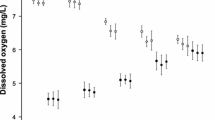Abstract
The purpose of this study was to understand the differences in tolerance to ammonium nitrate in four Iberian amphibians. Results showed a negative effect on amphibian survival and larvae total length. Three different tolerance groups on amphibian survival were established. The two first groups showed a higher reduction, around 90% and between 70 and 80% after 96 h exposition at the maximum concentration tested (180 mg NH4NO3/L), while the third group showed no mortality in any concentration tested. In addition, a reduction in larvae total length was also detected for all four species, with Bufo bufo as the most sensitive species.


Similar content being viewed by others
References
AMAP (1998) AMAP Assessment report: Arctic pollution issues. Arctic Monitoring and Assessment Program (AMAP), Oslo, Norway
Berger L (1989) Disappearance of amphibian larvae in the agricultural landscape. Ecol Int Bull 17:65–73
Blaustein AR, Wake DB (1995) The problem of declining amphibian populations. Sci Amer 272:52–57
Bogardi I, Kuzelka RD, Ennenga WG (1991) Nitrate contamination: exposure, consequence, and control. NATO ASI Series G-Ecological Sciences, vol 30. Springer, New York
Breden F, Kelly CH (1982) The effect of conspecific interaction on metamorphosis in Bufo americanus. Ecology 63:1682–1689
Egea-Serrano A, Tejedo M, Torralva M (2009) Populational divergence in the impact of three nitrogenous compounds and their combination on larvae of the frog Pelophylax perezi (Seoane, 1985). Chemosphere 76:869–877
García-Muñoz E, Guerrero F, Parra G (2009) Effects of copper sulfate on growth, development, and escape behavior in Epidalea calamita embryos and larvae. Arch Environ Contam Toxicol 56:557–565
García-Muñoz E, Guerrero F, Parra G (2010a) Intraspecific and interspecific tolerance to copper sulphate in five Iberian amphibian species at two developmental stages. Arch Environ Contam Toxicol 59:312–321
García-Muñoz E, Gilbert JD, Parra G, Guerrero F (2010b) Wetlands classification for amphibian conservation in Mediterranean landscapes. Biodivers Conserv 19:901–911
García-Muñoz E, Guerrero F, Parra G (in press) Effects of previous sublethal pulse to ammonium nitrate on mortality and total length on Epidalea calamita larvae. Chemosphere. doi:10.1016/j.chemosphere.2011.03.031
Gibbs JP, Whiteleather KK, Schueler FW (2005) Changes in frog and toad populations over 30 years in New York State. Ecol Appl 15:1148–1157
Gosner KL (1960) A simplified table for staging anuran embryos and larvae with notes on identification. Herpetologica 16:183–190
Hecnar SJ (1995) Acute and chronic toxicity of ammonium nitrate fertilizer to amphibians from southern Ontario. Environ Toxicol Chem 14:2131–2137
Jenkins A (1999) End of the acid rain. Nature 401:537–538
Mann RM, Hyne RV, Choung CB, Wilson SP (2009) Amphibians and agricultural chemicals: review of the risks in a complex environment. Environ Pollut 157:2903–2927
Ortiz-Santaliestra ME, Marco A, Fernández MJ, Lizana M (2006) Influence of developmental stage on sensitivity to ammonium nitrate of aquatic stages of amphibians. Environ Toxicol Chem 25:105–111
Rabalais NN (2002) Nitrogen in aquatic ecosystems. Ambio 31:102–112
Scholefield D, Lord EI, Rodda HJE, Webb B (1996) Estimating peak nitrate concentrations from annual nitrate loads. J Hydrol 186:355–373
Semlitsch RD, Scott DE, Pechmann JHK (1988) Time and size at metamorphosis related to adult fitness in Ambystoma talpoideum. Ecology 69:184–192
Sinsch U (1998) Biologie und Ökologie der Kreuzkröte. Laurenti Verlag, Bochum, Germany
Sullivan KB, Spence KM (2003) Effects of sublethal effects concentrations of atrazine and nitrate on metamorphosis of the African clawed frog. Environ Toxicol Chem 22:627–635
Watt PJ, Jarvis P (1997) Survival analysis in palmate newts exposed to ammonium nitrate agricultural fertilizer. Ecotoxicology 6:355–362
Wright PM, Wright PA (1996) Nitrogen metabolism and excretion in bullfrog (Rana catesbeiana) tadpoles and adults exposed to elevated environmental ammonia levels. Physiol Zool 69:1057–1078
Acknowledgments
This study was supported by the Ministerio de Educación y Ciencia (Spain) project (CGL2007-61482 co-funded by the European Regional Development Fund). E.G.-M. has a research grant from FCT post-doctoral program SFRH/BPD/78206/2010). Our thanks go to the C.M.A. (Junta de Andalucía) for permission to the amphibian surveys and to F. Ceacero for helpful suggestions. We also thank to anonymous referee whose helpful comments improved the manuscript.
Author information
Authors and Affiliations
Corresponding author
Rights and permissions
About this article
Cite this article
García-Muñoz, E., Guerrero, F., Bicho, R.C. et al. Effects of Ammonium Nitrate on Larval Survival and Growth of Four Iberian Amphibians. Bull Environ Contam Toxicol 87, 16–20 (2011). https://doi.org/10.1007/s00128-011-0289-9
Received:
Accepted:
Published:
Issue Date:
DOI: https://doi.org/10.1007/s00128-011-0289-9




